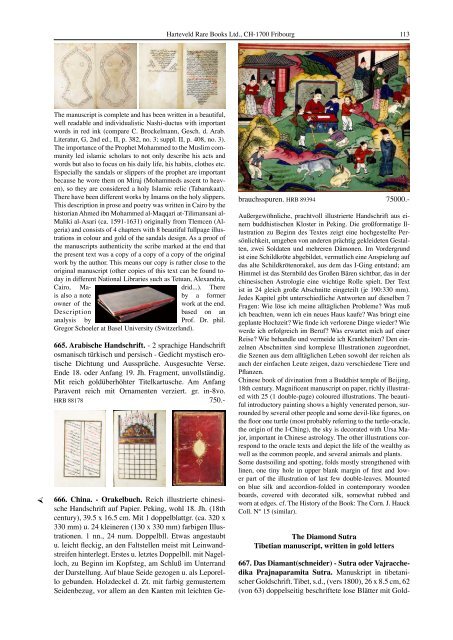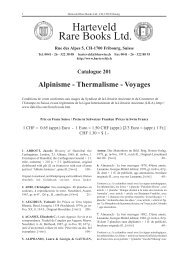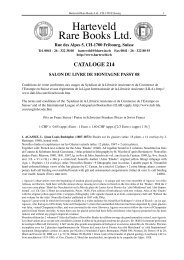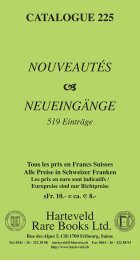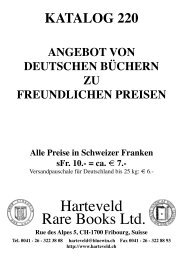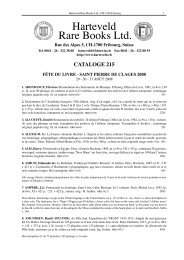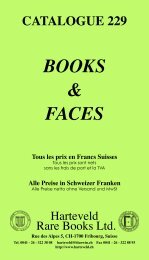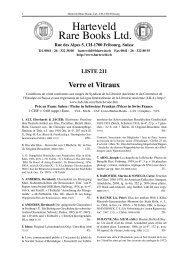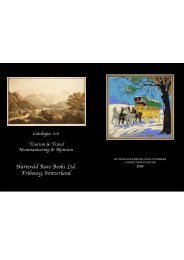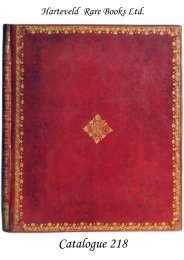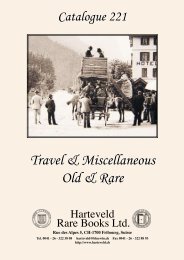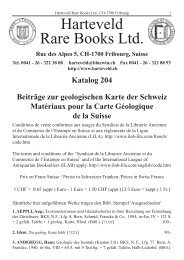Catalogue 217: CHF 20. - Harteveld Rare Books Ltd.
Catalogue 217: CHF 20. - Harteveld Rare Books Ltd.
Catalogue 217: CHF 20. - Harteveld Rare Books Ltd.
Create successful ePaper yourself
Turn your PDF publications into a flip-book with our unique Google optimized e-Paper software.
�<br />
The manuscript is complete and has been written in a beautiful,<br />
well readable and individualistic Nashi-ductus with important<br />
words in red ink (compare C. Brockelmann, Gesch. d. Arab.<br />
Literatur, G, 2nd ed., II, p. 382, no. 3; suppl. II, p. 408, no. 3).<br />
The importance of the Prophet Mohammed to the Muslim community<br />
led islamic scholars to not only describe his acts and<br />
words but also to focus on his daily life, his habits, clothes etc.<br />
Especially the sandals or slippers of the prophet are important<br />
because he wore them on Miraj (Mohammeds ascent to heaven),<br />
so they are considered a holy Islamic relic (Tabarukaat).<br />
There have been different works by Imams on the holy slippers.<br />
This description in prose and poetry was written in Cairo by the<br />
historian Ahmed ibn Mohammed al-Maqqari at-Tilimansani al-<br />
Maliki al-Asari (ca. 1591-1631) originally from Tlemcen (Algeria)<br />
and consists of 4 chapters with 8 beautiful fullpage illustrations<br />
in colour and gold of the sandals design. As a proof of<br />
the manuscripts authenticity the scribe marked at the end that<br />
the present text was a copy of a copy of a copy of the original<br />
work by the author. This means our copy is rather close to the<br />
original manuscript (other copies of this text can be found today<br />
in different National Libraries such as Tetuan, Alexandria,<br />
Cairo, Ma- drid...). There<br />
is also a note by a former<br />
owner of the work at the end.<br />
Description based on an<br />
analysis by Prof. Dr. phil.<br />
Gregor Schoeler at Basel University (Switzerland).<br />
665. Arabische Handschrift. - 2 sprachige Handschrift<br />
osmanisch türkisch und persisch - Gedicht mystisch erotische<br />
Dichtung und Aussprüche. Ausgesuchte Verse.<br />
Ende 18. oder Anfang 19. Jh. Fragment, unvollständig.<br />
Mit reich goldüberhöhter Titelkartusche. Am Anfang<br />
Paravent reich mit Ornamenten verziert. gr. in-8vo.<br />
HRB 88178 750.-<br />
666. China. - Orakelbuch. Reich illustrierte chinesische<br />
Handschrift auf Papier. Peking, wohl 18. Jh. (18th<br />
century), 39.5 x 16.5 cm. Mit 1 doppelblattgr. (ca. 320 x<br />
330 mm) u. 24 kleineren (130 x 330 mm) farbigen Illustrationen.<br />
1 nn., 24 num. Doppelbll. Etwas angestaubt<br />
u. leicht fleckig, an den Faltstellen meist mit Leinwandstreifen<br />
hinterlegt. Erstes u. letztes Doppelbll. mit Nagelloch,<br />
zu Beginn im Kopfsteg, am Schluß im Unterrand<br />
der Darstellung. Auf blaue Seide gezogen u. als Leporello<br />
gebunden. Holzdeckel d. Zt. mit farbig gemustertem<br />
Seidenbezug, vor allem an den Kanten mit leichten Ge-<br />
<strong>Harteveld</strong> <strong>Rare</strong> <strong>Books</strong> <strong>Ltd</strong>., CH-1700 Fribourg 113<br />
brauchsspuren. HRB 89394 75000.-<br />
Außergewöhnliche, prachtvoll illustrierte Handschrift aus einem<br />
buddhistischen Kloster in Peking. Die großformatige Illustration<br />
zu Beginn des Textes zeigt eine hochgestellte Persönlichkeit,<br />
umgeben von anderen prächtig gekleideten Gestalten,<br />
zwei Soldaten und mehreren Dämonen. Im Vordergrund<br />
ist eine Schildkröte abgebildet, vermutlich eine Anspielung auf<br />
das alte Schildkrötenorakel, aus dem das I-Ging entstand; am<br />
Himmel ist das Sternbild des Großen Bären sichtbar, das in der<br />
chinesischen Astrologie eine wichtige Rolle spielt. Der Text<br />
ist in 24 gleich große Abschnitte eingeteilt (je 190:330 mm).<br />
Jedes Kapitel gibt unterschiedliche Antworten auf dieselben 7<br />
Fragen: Wie löse ich meine alltäglichen Probleme? Was muß<br />
ich beachten, wenn ich ein neues Haus kaufe? Was bringt eine<br />
geplante Hochzeit? Wie finde ich verlorene Dinge wieder? Wie<br />
werde ich erfolgreich im Beruf? Was erwartet mich auf einer<br />
Reise? Wie behandle und vermeide ich Krankheiten? Den einzelnen<br />
Abschnitten sind komplexe Illustrationen zugeordnet,<br />
die Szenen aus dem alltäglichen Leben sowohl der reichen als<br />
auch der einfachen Leute zeigen, dazu verschiedene Tiere und<br />
Pflanzen.<br />
Chinese book of divination from a Buddhist temple of Beijing,<br />
18th century. Magnificent manuscript on paper, richly illustrated<br />
with 25 (1 double-page) coloured illustrations. The beautiful<br />
introductory painting shows a highly venerated person, surrounded<br />
by several other people and some devil-like figures, on<br />
the floor one turtle (most probably referring to the turtle-oracle,<br />
the origin of the I-Ching), the sky is decorated with Ursa Major,<br />
important in Chinese astrology. The other illustrations correspond<br />
to the oracle texts and depict the life of the wealthy as<br />
well as the common people, and several animals and plants.<br />
Some dustsoiling and spotting, folds mostly strengthened with<br />
linen, one tiny hole in upper blank margin of first and lower<br />
part of the illustration of last few double-leaves. Mounted<br />
on blue silk and accordion-folded in contemporary wooden<br />
boards, covered with decorated silk, somewhat rubbed and<br />
worn at edges. cf. The History of the Book: The Corn. J. Hauck<br />
Coll. N° 15 (similar).<br />
The Diamond Sutra<br />
Tibetian manuscript, written in gold letters<br />
667. Das Diamant(schneider) - Sutra oder Vajracchedika<br />
Prajnaparamita Sutra. Manuskript in tibetanischer<br />
Goldschrift. Tibet, s.d., (vers 1800), 26 x 8.5 cm, 62<br />
(von 63) doppelseitig beschriftete lose Blätter mit Gold-


